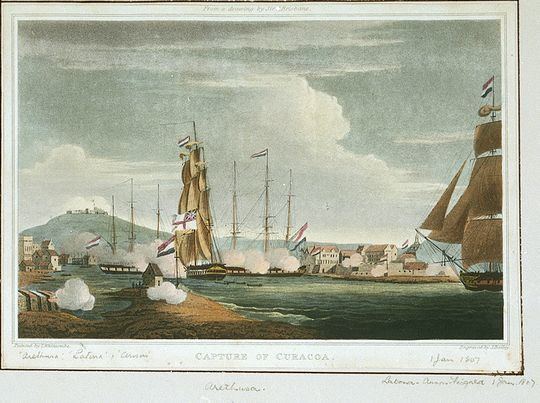Name HMS Latona Ordered 22 March 1779 Construction started October 1779 Length 43 m | Laid down October 1779 Launched 13 March 1781 | |
 | ||
Commissioned 21 April 1781 (after fitting out at Deptford Dockyard) | ||
HMS Latona was a 38-gun, 18-pounder gun armed fifth-rate frigate of the Royal Navy, launched in 1781. She served in the American revolution, the French Revolutionary Wars, and the Napoleonic Wars. Latona was hulked in 1813 and sold for breaking up in 1816.
Contents
Design
She was designed by the senior surveyor John Williams. In this era it was common for each surveyor to produce independent designs for new ship types, and this design was a counterpoint to Edward Hunt's HMS Minerva; together the two draughts represent the prototype of the thirty-eight gun, 18-pounder armed frigate.
Fourth Anglo-Dutch War
She participated in the 1781 Battle of Dogger Bank under the command of Sir Hyde Parker.
French Revolutionary Wars
Latona, under the command of F. Sotheron, on 29 November 1796 captured the French Bordeaux-based privateer schooner Aigle about 107 leagues N by W from Lisbon. She had left out of Passayes, near Bayonne, on 6 November, but had captured nothing. She was pierced for 14 guns but carried only 12 small carriage guns, and had a crew of 62 men under the command of Francis Harimendy.
Then a few days later, on 3 December, Latona captured the French brig Intrepide 40 leagues WNW of Lisbon. She was pierced for 18 guns but carried twelve 6-pounders, an 18-pounder carrronade, and a brass 12-pounder gun. During the chase she threw all her guns overboard except for the 12-pounder and one 6-pounder, both of which she used as stern chasers, firing, but without effect, until Latona was almost alongside. She had a crew of 83 men aboard, under the command of M. Jean Candeau. On her cruise she had captured only one vessel, a galliot belonging to Bremen, which had been sailing from Faro to Liverpool with a cargo of fruit.
Between 8 March 1799 and 12 May, Latona captured a large number of small Dutch vessels.
Napoleonic Wars
Latona, commanded by T.L.M. Gosselin, captured the Spanish ketch Amphion, armed with 12 guns and 70 men, at sea on 22 October 1805.
On 1 January 1807 Latona, Arethusa, Anson, Fisgard, and Morne Fortunee captured Curaçao. The Dutch resisted and Latona lost one men killed and two wounded; in all, the British lost three killed and 14 wounded. On the ships alone, the Dutch lost six men killed, including Commandant Cornelius J. Evertz, who commanded the Dutch naval force in Curaçao and seven wounded, of whom one died later. With the colony, the British captured the frigate Kenau Hasselar, the sloop Suriname (a former Royal Naval sloop), and two naval schooners. In 1847 the Admiralty authorized the issue of the Naval General Service Medal with clasp "Curacoa 1 Jany. 1807" to any surviving claimants from the action; 65 medals were issued.
Latona was part of the squadron under Admiral Sir Alexander Cochrane that captured the Danish islands of St Thomas on 22 December and Santa Cruz on 25 December 1807. The Danes did not resist and the invasion was bloodless.
At the Action of 10 February 1809, Latona was involved in the capture of HMS Junon in the West Indies.
In April 1809, a strong French squadron arrived at the Îles des Saintes, south of Guadeloupe. There they were blockaded until 14 April, when a British force under Major-General Frederick Maitland and Captain Philip Beaver in Acasta, invaded and captured the islands. Latona was among the naval vessels that shared in the proceeds of the capture of the islands.
On 7 June 1809 Latona was under the command of Captain Hugh Pigot. On that day she captured the French 36-gun frigate Félicité.
